This Goan Caldin Curry (Caldinho), is a yellow, mildly spiced, creamy, and flavorful curry, often made with Pomfret, fish, prawns, or vegetables, from Goa, India. Goan Caldine uses minimal spices and freshly extracted coconut milk, perfect for those who love light, flavorful curries. Pomfret fish is commonly used and can be made with other fish, prawns, or even vegetables. Serve with steamed rice or crusty bread. Here’s how to make it with step-by-step photos and a recipe video.
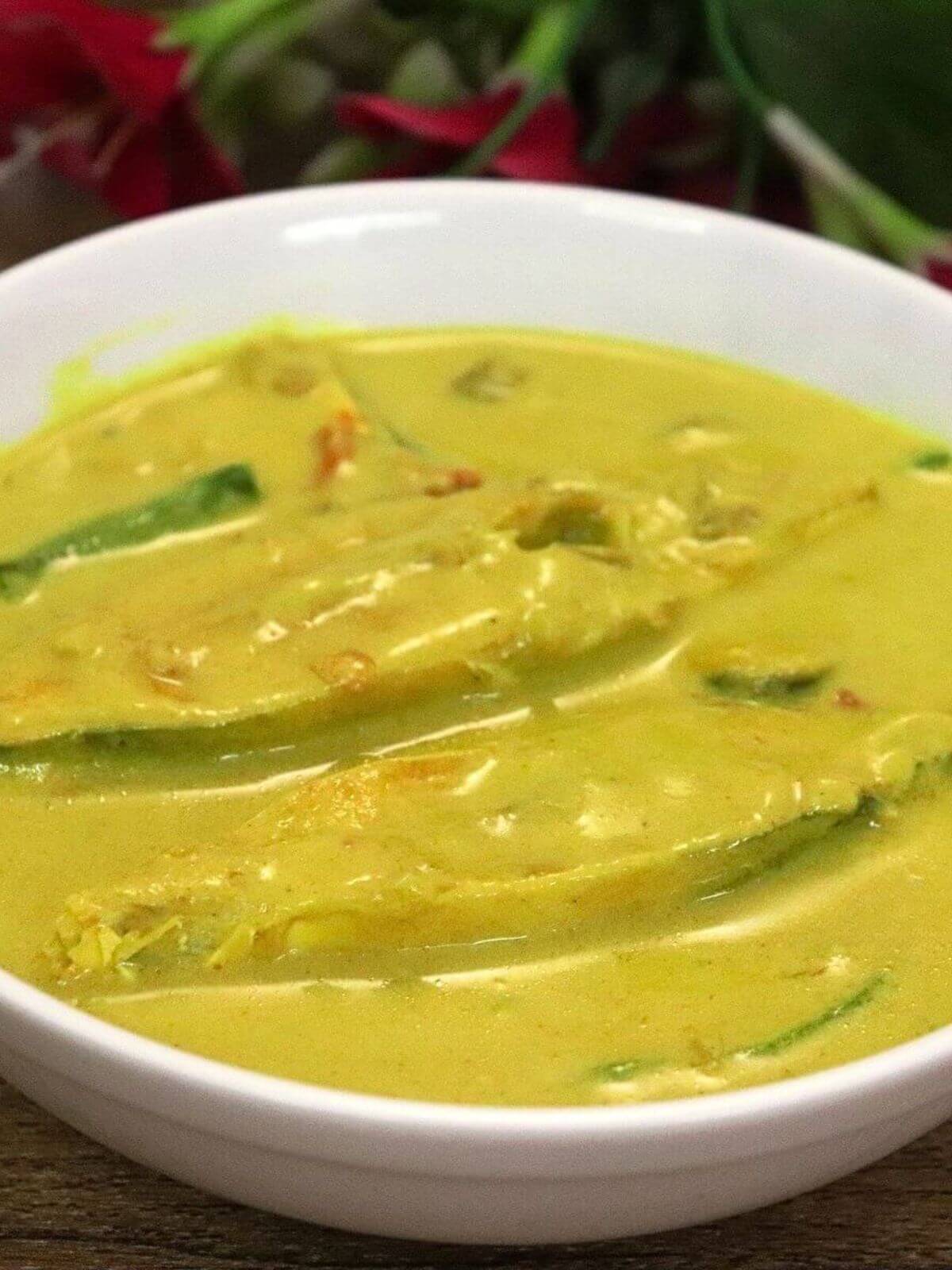
Jump to:
This is my go-to Caldin curry recipe because it’s mildly spicy, perfect for kids, and always a hit at family dinners. I first tasted Fish Caldin at a beachside restaurant, and its light, coconut flavor instantly won me over. Unlike spicy fish curries, caldin skips red chilies and has mild heat from green chilies, creaminess from coconut milk, and flavored with aromatic spices.
What sets this Caldin Curry apart for me is its versatility. I can easily swap the seafood for chicken, vegetables, or even tofu. It is best enjoyed with steamed rice or crusty bread. Love Goan Seafood Recipes? You might also like Goan Prawn Curry, Prawn Ambotik, Goan Fish Curry, Stuffed Mackerels, Goan Ambotik, and Green Masala Fish Fry.
About This Fish Caldin
This Goan Fish Caldin recipe, I am sharing here is a mild spicy, absolutely creamy, and flavorful Goan Pomfret fish curry. The name "Caldin" (or "Caldinho" in Portuguese) translates to "small soup" or "broth."
Caldin curry is mild and coconut milk extract gives it a broth-like texture, and light, soupy consistency, which sets it apart from heavier, spicier Goan curries like Goan Chicken Xacuti, Chicken Cafreal, or Goan Chicken Vindaloo.
This Pomfret Caldin uses minimal spices like cumin, peppercorns, turmeric, and coriander, blended with coconut, which is passed through a sieve to extract coconut milk, creating a creamy curry base that's both comforting and light. Caldine tastes best when served warm with rice or bread.
You may also like these other popular seafood recipes from this website:
Ingredients Notes
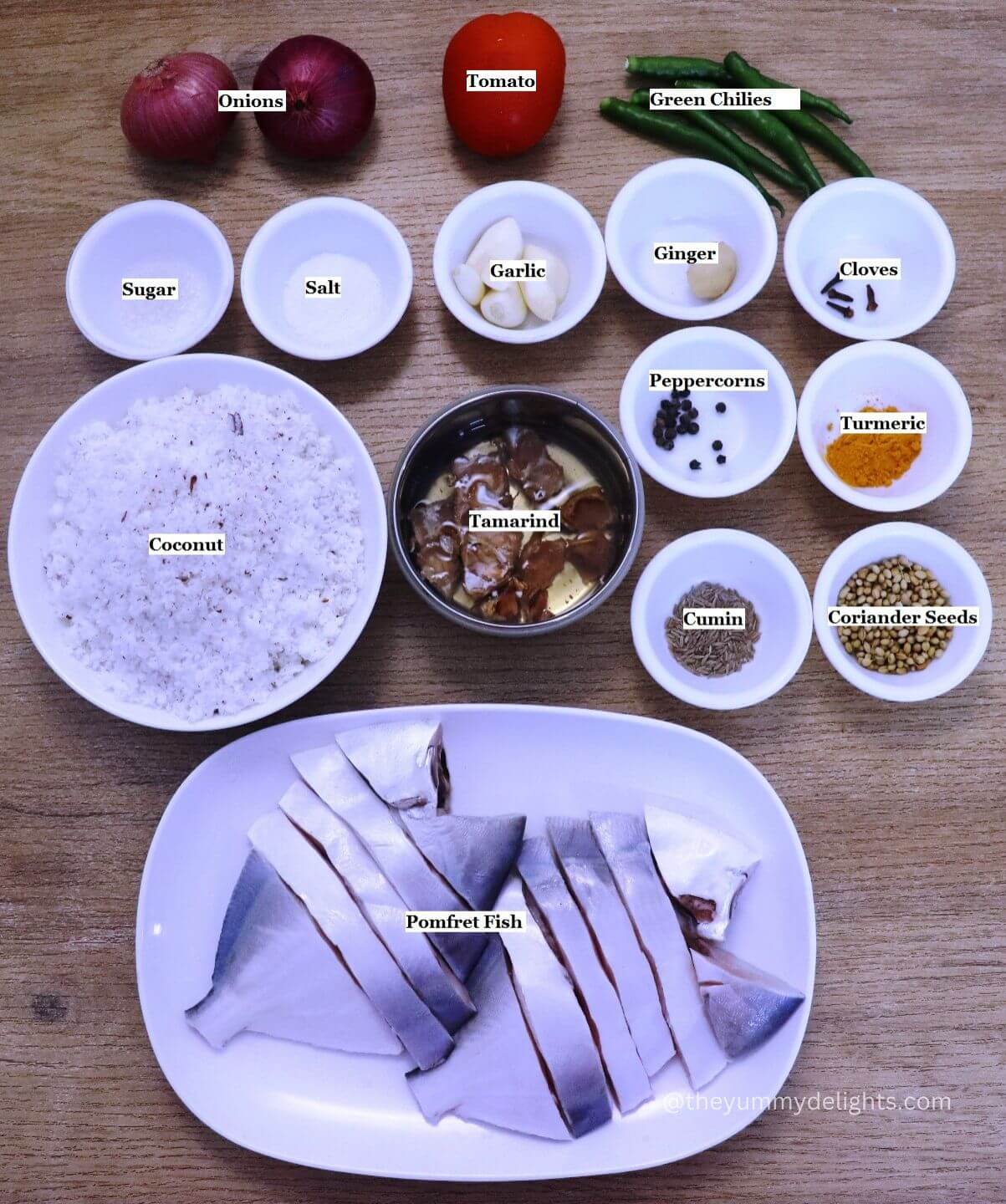
- Fish: Pomfret is the classic choice for this Goan Caldin, but don’t worry if you can’t find it any other fish like kingfish, prawns, or even vegetables work beautifully for this recipe. It is a super versatile curry, Prawn Caldin or Veg Caldin are equally popular.
- Tamarind: This is a staple in Goan coastal cooking, adding that gentle tang to your Goan curry. If you don’t have tamarind on hand, add vinegar to this caldin recipe.
- Caldin Masala: You’ll need freshly grated coconut, coriander seeds, cumin, peppercorns, cloves, ginger, garlic, turmeric, and green chilies. A quick tip: desiccated coconut won’t work here, but full-fat coconut milk is a great substitute.
- Green Chilies: Caldin is meant to be mild, but if you love a little heat, go for spicier green chilies. Adjust the quantity based on your taste.
- Onions: I used red onions but feel free to swap in yellow or white onions for this Goan seafood curry.
- Tomato: Fresh, ripe red tomatoes give the curry a beautiful flavor and a slight tang. Canned tomatoes work too.
For the detailed list of ingredients & their measurements, please check out the recipe card below. Here’s how to make Fish Caldin.
How To Make Goan Caldin Curry (With Step-By-Step Photos)
Preparations to make Fish Caldin
1) Marinate the fish: Marinate fish with salt and turmeric, ensuring it's evenly coated. Set aside. Also, soak the tamarind in hot water for 15 minutes. Set aside.
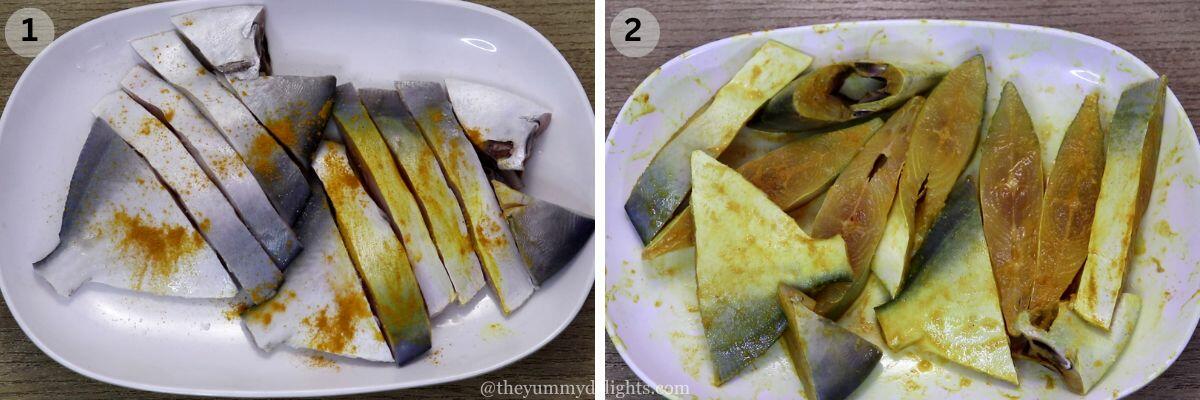
2) Preparing coconut milk extract: In a blender, combine coconut, coriander seeds, cumin, peppercorns, cloves, ginger, garlic, turmeric, and green chilies. Add 1.5 cups of water and blend to a smooth paste.
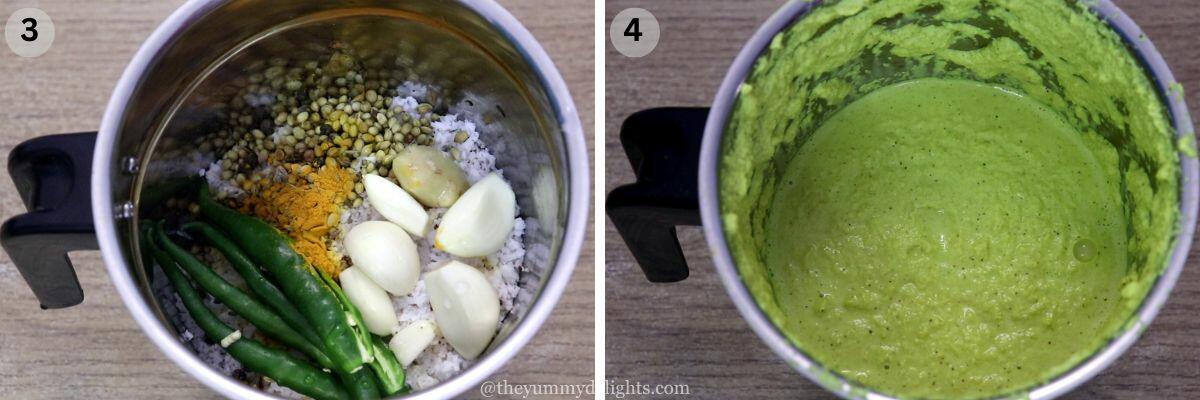
3) First coconut milk extract: Strain the mixture to extract the first coconut milk. This is thick and creamier. Always added towards the end of cooking the curry. Set aside.
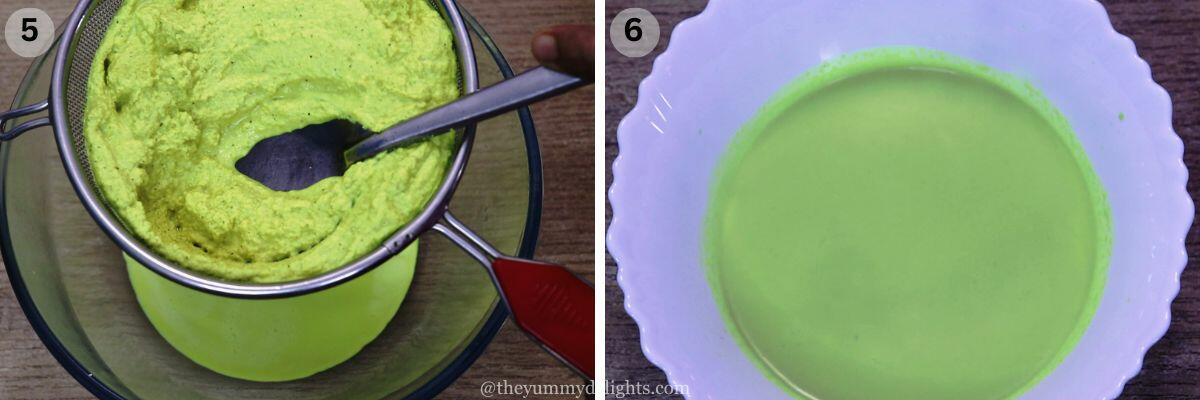
4) Second coconut milk extract: Return the remaining coconut mixture to the blender. Add 1 cup of water and blend again to a smooth paste. Strain the mixture in a separate bowl, to extract the second coconut milk. This is thin coconut milk and is used to cook curry. Set aside.
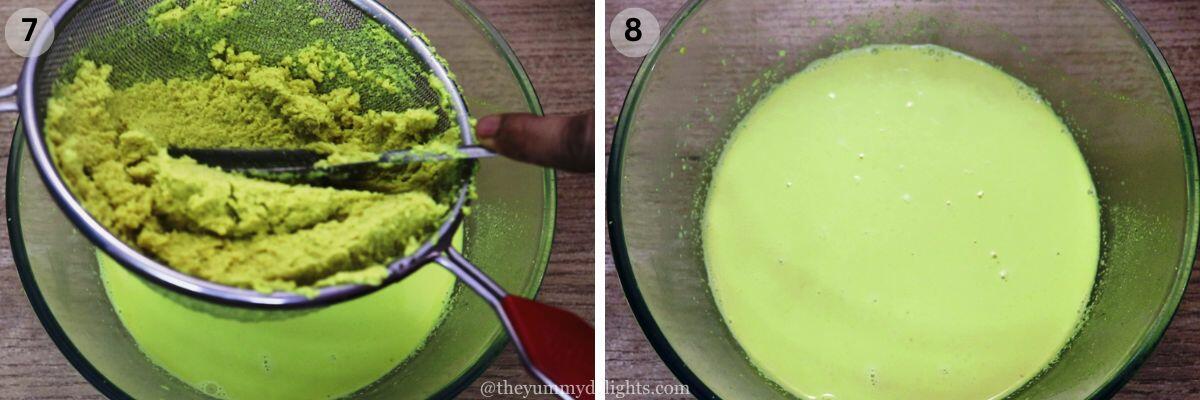
5) Third coconut milk extract: This step is optional. You can proceed to the next step after the second extract. Return the remaining mixture to the blender. Add ½ cup of water and blend again. This is the third extract (thinnest). Strain it into the same bowl (used for the second extract).
6) Squeeze the soaked tamarind to extract the pulp, and strain it.
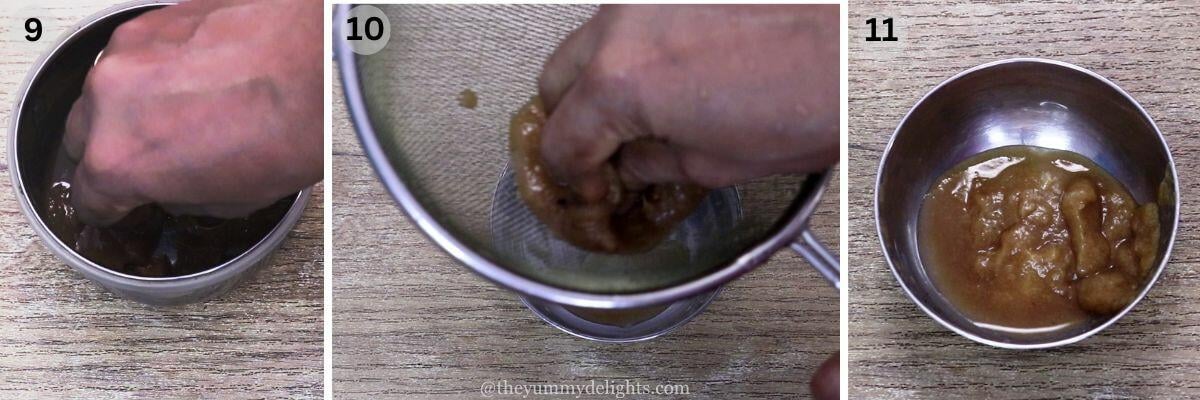
Making Goan Caldin Curry
1) Heat 2-3 teaspoons of oil over medium heat. Add the onions and sauté until golden brown. Add the tomatoes and sauté until they soften and become pulpy.
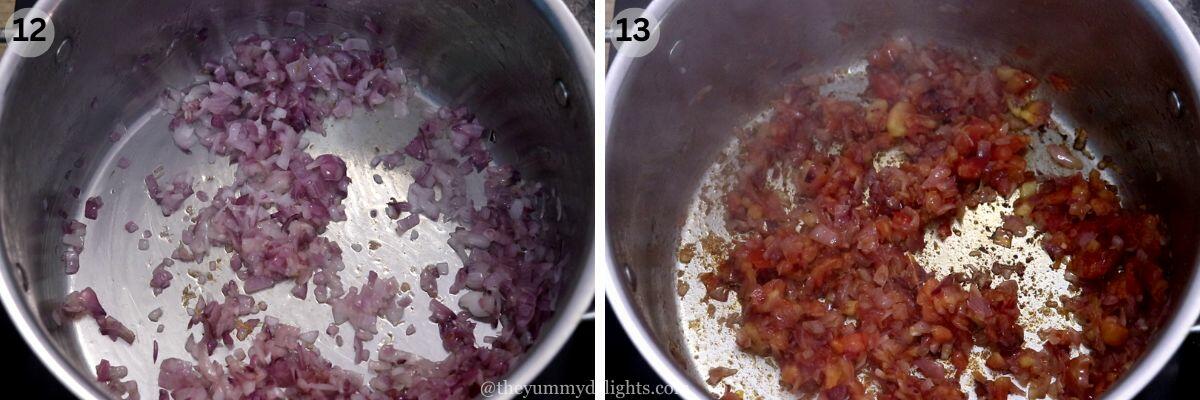
2) Lower the heat. Add the second and third strained coconut extracts. Stir and cook for 2 minutes.
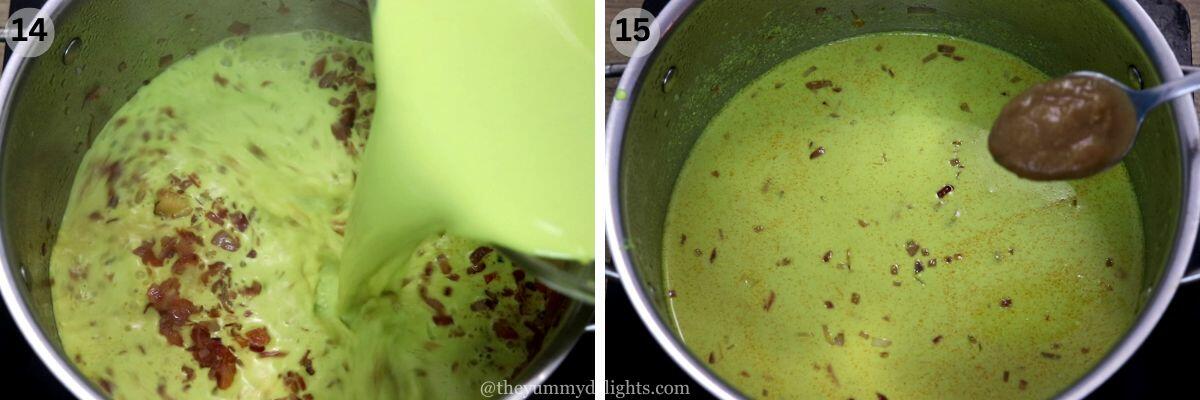
3) Add the tamarind pulp, salt, and green chili (optional). Add more green chilies if you prefer a spicier curry.
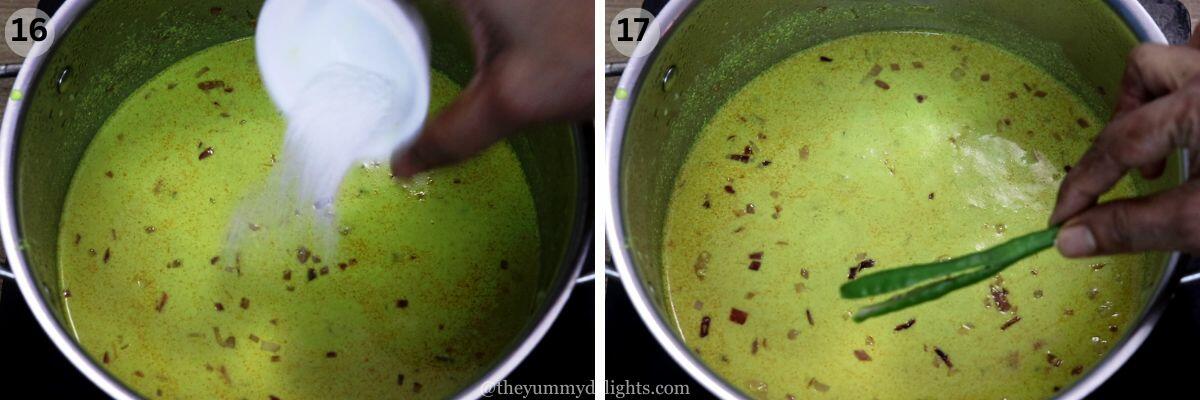
4) Increase the heat to medium and bring the mixture to a boil, stirring to combine. Gently add the marinated fish. Do not stir.
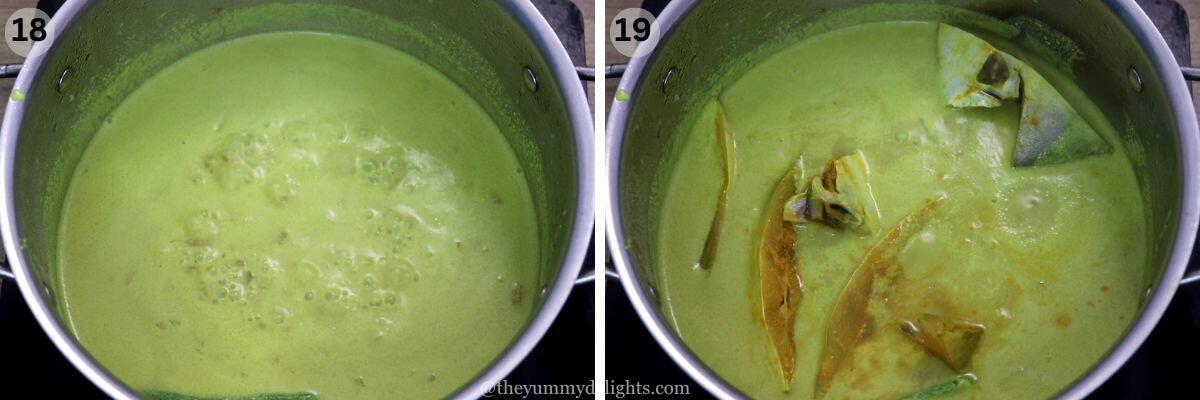
5) Hold the panhandles firmly, and rotate the pan to combine. If your pan doesn't have handles, use a cloth to hold the sides of the pan/pot and rotate.
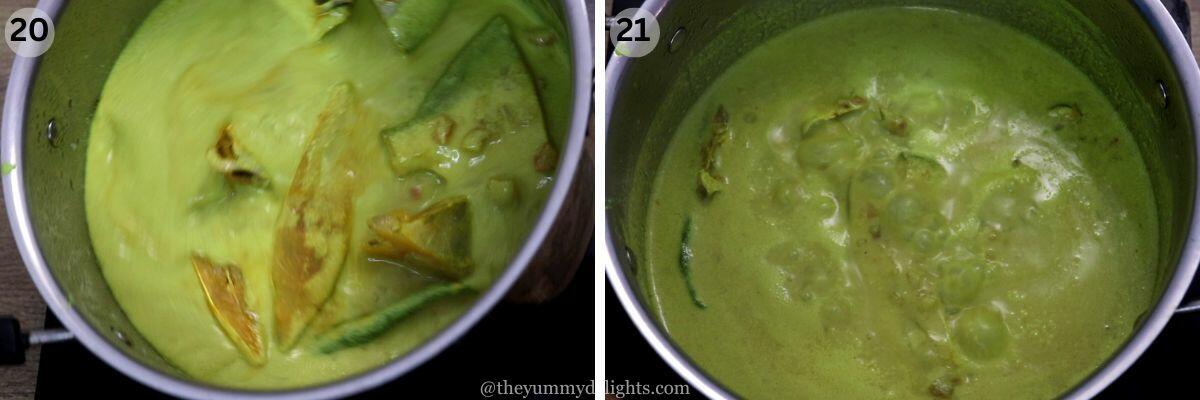
6) Add 1 teaspoon of sugar and bring the curry back to a boil. Reduce the heat to low. Add the first coconut milk extract. Cook for 1-2 minutes on low heat until heated through.
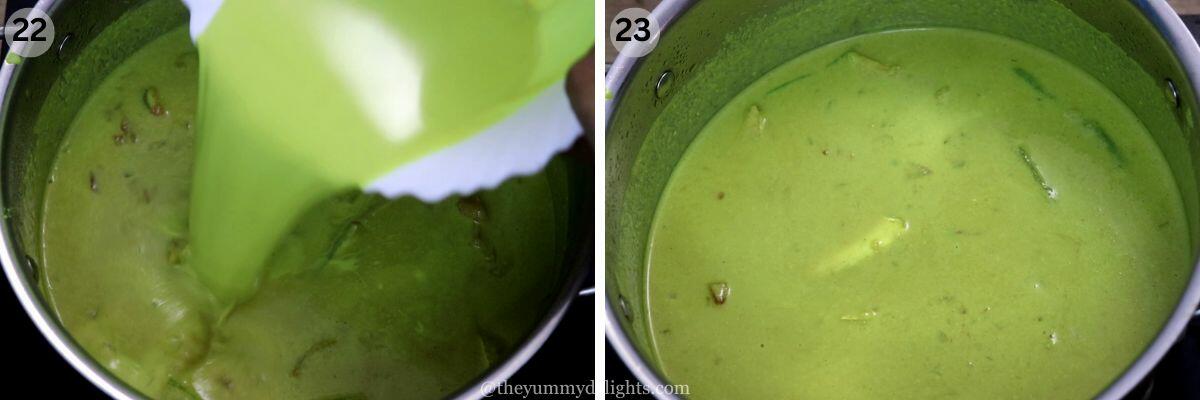
7) Do not boil after adding the first coconut milk extract, as high heat can cause the coconut milk to split giving a grainy texture to the curry. The fish caldin is ready to serve. It's a delicious, creamy curry with a mild flavor. I like to serve the Pomfret caldin with rice.
Tips for the Best Caldine Curry
- Use fresh coconut milk: I like to use freshly extracted coconut milk gives the best Caldin flavor. If you are using canned coconut milk then go for full-fat coconut milk.
- Don’t overcook the fish: Pomfret cooks quickly, so add it towards the end to keep it tender.
- Adjust spice levels: While Caldine is a mild curry, you can add extra green chilies or peppercorns for heat.
- Do not add extra green chilies while grinding the masala, or the curry may develop a slight green color. Better to slit the chilies and add them while sautéing the onions. I made this mistake while making this Goan Caldin first time.
- Cooking with fresh coconut milk: Third & second extracts are added first. This helps build flavor without making the curry too rich too soon. You can boil this extract. The first (thick) extract is added at the end. Lower the heat and let it simmer gently. Boiling can cause the first coconut milk extract to separate, making the curry look grainy.
Frequently Asked Questions
I like to serve Caldin with steamed rice or Goan Pav/Poee (Goan Bread). You can serve it with any cooling salad like cucumber tomato salad or greek yogurt cucumber salad, papad, curd chilies, or pickles as a side dish. We also like to have Goan king fish fry, Andhra fish fry, or Prawn fry as a side dish.
Storing: Store the leftover Caldin within 2 hours of cooking. Transfer it to an airtight container and refrigerate. It stays good for 2 days. Not a freezer-friendly recipe. Sometimes coconut milk can separate once you thaw it.
Reheating: Warm the curry gently on low heat, stirring occasionally. Add a splash of water or coconut milk if the curry thickens too much.
No, Caldin is one of the mildest Goan curries. Unlike Xacuti or Vindaloo, it uses coconut milk for creaminess and aromatic spices for flavor. No red chilies or heavy spices are used to make this curry.
You can replace coconut with full-fat coconut milk. Gives the same flavors.
Variations: Veg, Fish, and Prawn Caldin
- Fish Caldin – Use Pomfret, or Kingfish for best results. Traditionally, Pomfret is the preferred fish for Caldin due to its delicate, firm flesh that absorbs the mild flavors of lightly spiced coconut milk.
- Prawn Caldin – Use fresh prawn (medium or Jumbo) for the best taste. Prawns give the curry a rich seafood flavor, making it slightly different from fish Caldin.
- Vegetarian Caldin – Swap fish for cauliflower, okra, mushrooms, or tofu for a delicious vegetarian version.
If you try this recipe, please leave a comment and rating below. We'd love to hear your feedback.
And, follow me on social media so we can stay connected. I’m on Facebook, Pinterest, and YouTube
Recipe Card
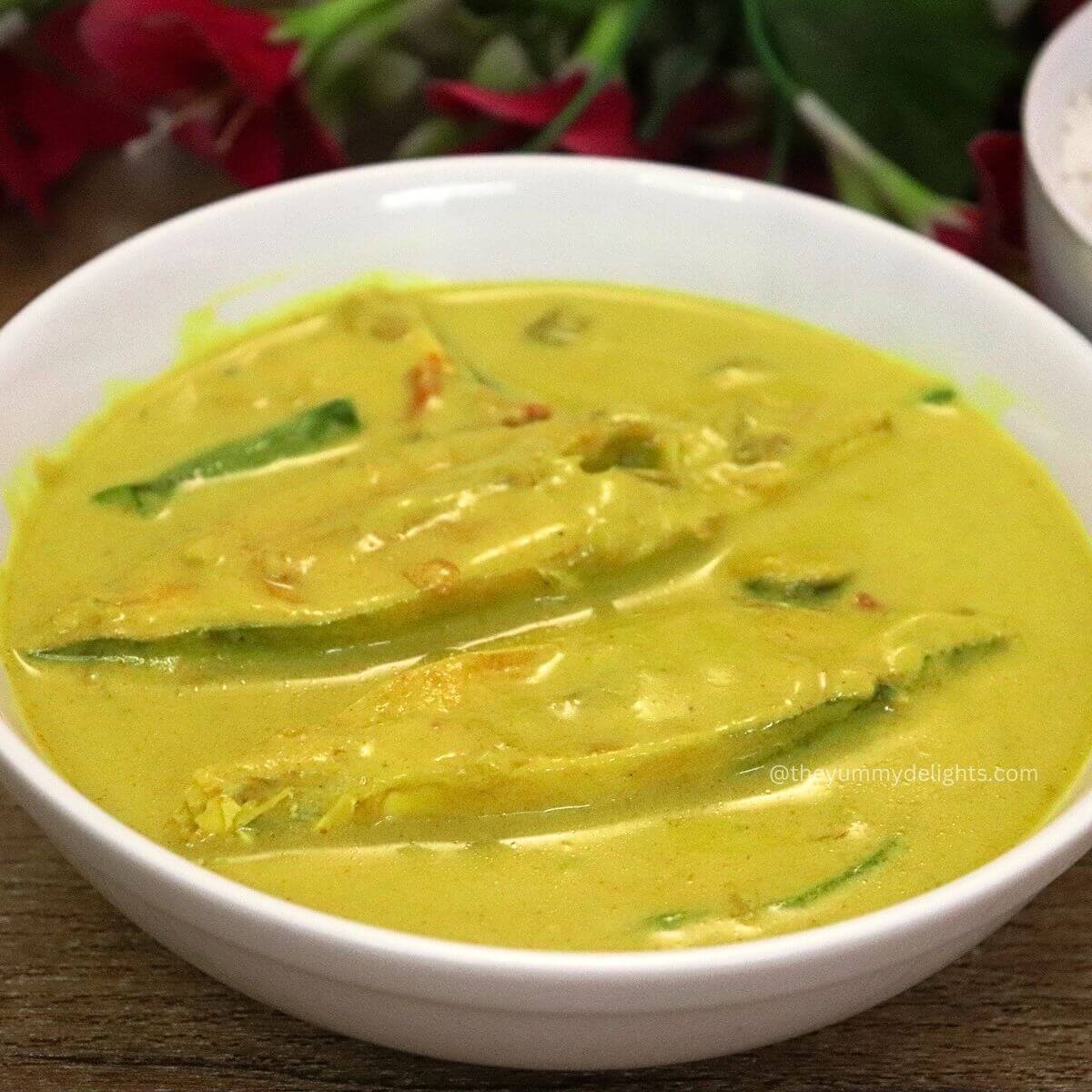
Goan Caldin Curry Recipe
Video
Equipment
- 1 medium size mixing bowl
- 1 Strainer or muslin cloth
- 1 Mixer/Blender Jar
- 1 Heavy bottom pan
Ingredients
To marinate the fish
- 2 Pomfret fish, (also called Paplet) (500 grams)
- ½ teaspoon salt
- 1 teaspoon turmeric
Caldin Masala
- 2 cups coconut 1 whole coconut, scraped
- 1.5 tablespoon coriander seeds
- 1 teaspoon cumin
- 25 peppercorns
- 4-6 cloves
- 1- inch ginger
- 6 garlic cloves big size, if using small size garlic - add 12 garlic cloves
- 1 teaspoon turmeric
- 4 green chilies spicy, add as per taste
Caldin curry
- 2-3 teaspoon oil
- 2 onions chopped
- 1 tomato chopped
- 1 green chili
- salt to taste
- 1 teaspoon sugar
- ½ lemon size ball of tamarind (Soak it in hot water for 15 minutes)
Instructions
Preparations to make Fish Caldine
- Marinate the fish: Marinate the fish with salt and turmeric, ensuring it's evenly coated. Set aside. Also, soak the tamarind in hot water for 15 minutes. Set aside.
- Preparing first coconut extract: In a blender, combine coconut, coriander seeds, cumin, peppercorns, cloves, ginger, garlic, turmeric, and green chilies. Add 1.5 cups of water and blend to a smooth paste. Strain the mixture to extract the first coconut milk. This is thick and creamier. Always added towards end of cooking the curry. Set aside.
- Second coconut milk extract: Return the remaining coconut mixture to the blender. Add 1 cup of water and blend again to a smooth paste. Strain the mixture in a separate bowl, to extract the second coconut milk. This is thin coconut milk and is used for cooking the curry. Set aside.
- Third coconut milk extract: This step is optional. You can proceed to the next step after the second extract. Return the remaining mixture to the blender. Add ½ cup of water and blend again. This is the third extract (thinnest). Strain it into the same bowl (used for second extract).
- Squeeze the soaked tamarind to extract the pulp, and strain it.
Making Goan Caldine Curry
- Heat 2-3 teaspoons of oil over medium heat. Add the onions and sauté until golden brown. Add the tomatoes and sauté until they soften and become pulpy. Lower the heat. Add the second and third strained coconut milk extracts. Stir and cook for 2 minutes.
- Add the tamarind pulp, salt, and green chili (optional). Add more green chilies if you prefer a spicier curry. Increase the heat to medium and bring the mixture to a boil, stirring to combine.
- Gently add the marinated fish. Do not stir. Hold the pan handles firmly and rotate the pan to combine. If your pan doesn't have handles, use a cloth to hold the sides of your pan/pot and rotate.
- Add 1 teaspoon of sugar and bring the curry back to a boil. Reduce the heat to low. Add the first coconut milk extract. Cook for 1-2 minutes on low heat until heated though. Do not boil after adding the first extract, as high heat can cause the coconut milk to split giving grainy texture to the curry. Fish caldin is ready to serve. It's a delicious, creamy curry with a mild flavor. I like to serve the Pomfret caldine with rice.
Notes
- Use fresh coconut milk: I like to use freshly extracted coconut milk gives the best Caldin flavor. If you are using canned coconut milk then go for full-fat coconut milk.
- Don’t overcook the fish: Pomfret cooks quickly, so add it towards the end to keep it tender.
- Adjust spice levels: While Caldin is a mild curry, you can add extra green chilies or peppercorns for heat.
- Do not add extra green chilies while grinding the masala, or the curry may develop a slight green color. Better to slit the chilies and add them while sautéing the onions. I made this mistake while making the curry first time.
- Cooking with fresh coconut milk: Third & second coconut milk extracts are added first. This helps build flavor without making the curry too rich too soon. You can boil this extract. The first (thick) extract is at the end. Lower the heat and let it simmer gently.
- Boiling can cause the first coconut milk extract to separate, making the curry look grainy.
- Storing and Reheating:
- Storing: Store the leftover Caldin within 2 hours of cooking. Transfer it to an airtight container and refrigerate. It stays good for 2 days. Not a freezer-friendly recipe. Sometimes coconut milk can separate once you thaw it and reheat.
- Reheating: Warm the curry gently on low heat, stirring occasionally. Add a splash of water or coconut milk if the curry thickens too much.
- Read our full nutrition disclaimer here.
Nutrition
Nutrition information is automatically calculated, so should only be used as an approximation.

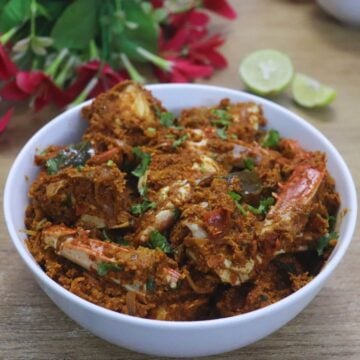


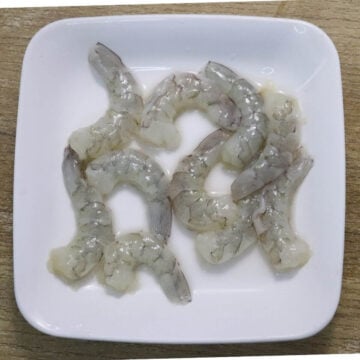
Preeti
I'm so happy to share my recipe for this classic chicken curry. This fish cladin curry is truly a game-changer. You'll love its rich flavor and creamy texture. It's perfectly mild, making it an excellent choice for anyone who wants to try a unique and delicious fish recipe. This one is a true Goan classic.